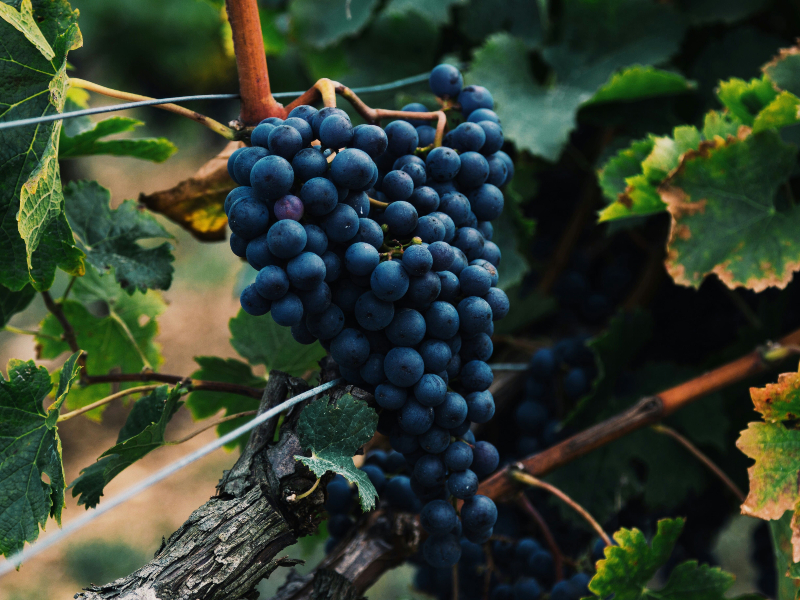When you turn to Bonarda, you’re speaking to the soul of Argentine wine. With over 17,448 hectares under vine, Argentine Bonarda, the red variety, is only outdone by Malbec, which boasts 46,565 hectares in all. Interestingly, at the end of the twentieth century, it was Bonarda that was in the lead, which may explain why it is so popular in the country.
Introduced by European immigrants at the end of the 19th century, Bonarda adapted easily to the dry, warm climates of Mendoza and San Juan, the largest wine-producing provinces in Argentina. Its output grew throughout the 20th century due to its popularity with producers; it was easy to manage, offered excellent yields and was perfect for the mild, fruity wines that were drunk for decades in Argentina.
At the beginning of the 21st century, producers decided to modernize the style of their wines and some wineries developed the first premium Bonardas, raising their status and prestige. The goal was to make it a worthy companion for Malbec.
The big surprise came in 2009 when it was discovered that the Bonarda planted in Argentina wasn’t the same variety as that planted in Piedmont but actually Corbeau Noir, a variety that originated in Savoy in the French Alps. To preserve the name by which it was commonly known, the variety was thus re-christened Argentine Bonarda as, after years of adaptation, the variety had a quite different character to that of the red from Savoy. In addition, it was decided that it would be celebrated every first week of August to encourage fans to share their love of the grape with other wine-drinkers.
Today, the grape is used in a large variety of wines that encapsulate an authentically Argentine flavor, making it one of the most strategically valuable varieties in Argentine viticulture. Sebastián Zuccardi, who has always believed in the grape’s potential, says, “The importance of Bonarda on the Argentine viticultural scene lies in its adaptability to warm regions, which has convinced winegrowers to trust in it for many years.”
Angelina Yañez, the Winemaker at Lamadrid Wines, says: “It’s a variety that has an interesting history and that has evolved strikingly in Argentina, not just in the Cuyo region but also in the north. Before, it was used to make light wines designed to be drunk young. Today, thanks to more precise practices in the vineyard and more modern production techniques, we can make it in different styles, from fresh and young to balanced, complex cellar wines, making them an interesting and different option for consumers.”
Thanks to these new approaches, today Argentine Bonarda produces fresh, elegant wines that are bound to win over more and more drinkers.
What should consumers expect from an Argentine Bonarda?

Leonardo Devia, the oenologist at Chakana, an organic winery who make an Argentine Bonarda with no added sulfites, says, “Today it’s not easy to define Argentine Bonardas as they’re grown in different regions and made in different ways. You’ll always get fruitiness with a balsamic and herbal character, and good body and gentle tannins due to the thin skin. Fortunately, more and more producers are daring to make different kinds of Bonarda.”
In San Rafael, Mendoza, Daniel Pomar at Bodega Iaccarini, adds: “We use Bonarda in all our lines because the variety has adapted so well to our terroir.” The winery has an Argentine Bonarda vineyard that was first planted in 1947 whose grapes are used for their Gran Reserva. “It’s not an easy variety to work with because it’s so productive and that needs to be limited to make quality wines.” It’s important to mention that it has a long ripening cycle resulting in moderate alcohol levels that peak at 13.5 percent with gentle, easy to drink tannins.
A lot of winemakers agree that Argentine Bonarda is the ideal grape for fresh, light wines such as those sought after by new, younger consumers. Francisco Puga, the oenologist at Porvenir de Cafayate, in the Argentine northwest, says, “Bonarda could be to Malbec what Beaujolais Gamay is to Pinot Noir in Burgundy. It’s an ideal variety for fresh, mild wines and lends itself very well to carbonic maceration. There’s a great opportunity there to make simple, flavorful wines.”
Meanwhile, Lis Clement at Finca Feliz, says, “We have enhanced the virtues of Bonarda, its elegance, freshness and noble tannins, characteristics that get lost in blends or large runs. When we started to focus on getting the best out of it, we were surprised: it stands on its own as a varietal. That’s the best way to go, regardless of how each winery decides to approach it. The potential of Bonarda lies in its ability to adapt very well to areas such as the east of Mendoza.”
Which Argentine Bonarda should you try?

There are plenty of labels that offer a delicate, taut, fresh Bonarda. There are Carbonic Macerations, natural wines with no added sulfites, and even a few rosés and sparkling versions that might surprise you.
Those that prefer the latter kind of style might like to begin with Alfil Tinto from Finca Los Dragones or Cara Sur Rosado (with 50% Syrah), both of which come from the Calingasta Valley in San Juan. From Luján de Cuyo, there’s Nieto Senetiner Patrimonial Bonarda and Proyecto Las Compuertas Charbono. From the Uco Valley, Zorzal Eggo Bonaparte and Vuelá Bonarda from Piedra Negra. From the east of Mendoza, it’s worth trying Tesoro from Finca Feliz, Tinto del Este by Matías Morcos and Pala Corazón by Lucas Niven.
From Salta, Pequeñas Fermentaciones Bonarda from Porvenir de los Andes is a must. For those who like natural wines, there’s La Marchigiana from Catena Zapata and Chakana Sobrenatural.
Outstanding versions of more traditional, substantial, juicy and intense styles with excellent freshness include Emma Zuccardi Bonarda, Cavas Don Nicasio Gran Reserva Bonarda, Riccitelli Vino de Finca Bonarda, Lamadrid Reserva Bonarda, Colomé Lote Especial Bonarda and the classic Nieto Senetiner Bonarda Limited Edition.
Argentine Bonarda has come a long way from being misidentified for decades. Now it is a variety with its own style and reputation and it surely still has plenty of surprises in store.



